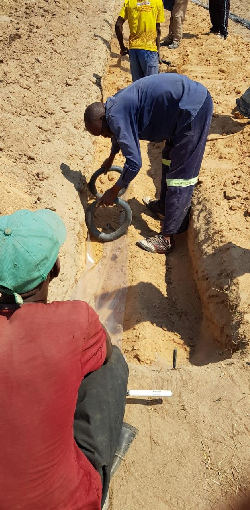To grow healthy crops, farmers need just the right mix of Sun, rain, and warmth—all of which are becoming more unpredictable with climate change. Farmers in sub-Saharan Africa are particularly vulnerable; regional droughts, heat waves, and invasive pests are all expected to become more common as the world warms.
Agriculture in the region has long faced two main challenges: a scarcity of water and sandy soils that don’t hold onto water or nutrients well. More than a fifth of the continent is covered by these kinds of highly permeable soils. The standard remedy—irrigation—is not an option for many smallholder famers in Africa, thanks to the high costs of irrigation technology and the low abundance of water. Just 4% of cultivated land across Africa is fed by irrigation systems.
But another option, a subsurface water retention technology (SWRT) that creates “microreservoirs” around root zones, could help several countries across sub-Saharan Africa collectively increase crop production by as much as 50 million tons per season, according to a study published in Frontiers in Sustainable Food Systems.
The microreservoirs are created by burying impermeable, U-shaped membranes a few inches below crop fields. The depth of the barriers depends on several factors—root length, how deep farmers till the earth, soil type, and local climate—but once in place, the membranes retain water, nutrients, and oxygen exactly where plants need them.
A Natural Solution

The idea for the membranes came from nature, according to Alvin Smucker, a study author and professor emeritus at Michigan State University. “We’ll give God the credit,” Smucker said.
In the mid-20th century, soil scientists discovered a layer of clay and silt in the sandy soils near Lake Michigan. “Some of the farmers in that area were saying, ‘What’s happening in this corner of my field? The vegetables are growing like we’re irrigating them every day.’ They didn’t know why,” Smucker said. “The answer is that [clay and silt] layer, about one half inch [1.27 centimeters] thick, held the water longer than the sand that didn’t have it.”
The natural barrier gave Smucker, then a graduate student, and his colleagues the idea for a machine that would lay down an artificial one. The original design involved burying a layer of asphalt belowground. He returned to the idea decades later, swapping out the asphalt layer for one made of impermeable polyethylene membranes.
Rather than a single continuous layer, the individual membranes are buried at varying depths, with gaps left between. This irregular patterning allows roots to grow around the membranes and excess water to drain, preventing plants from drowning when heavy rainfall occurs. The polyethylene materials are highly durable and can stay in place for decades with no maintenance.
“How long does it last? Longer than any of us will live,” Smucker said. “We know it’s at least 50 years. It will probably last for four to five generations. Nothing but a ground hog can go through it.”
“It seems like a promising technology,” said Michael Mulvaney, an assistant professor who studies cropping systems at the University of Florida and who was not involved in the study. There’s a need for innovation in the agriculture industry to address both nutrient pollution and water shortages in the era of climate change, he says. “If it retains water in that rooting zone for a longer period of time, that means crops should be more resistant to drought, which could have implications for adaptation or resilience to climate change.”
Labor and Installation Costs
Some experts say the labor involved in installing the membranes could affect adoption rates in developing countries. “If it’s installed during the dry season, soils can be hard as concrete,” said Mulvaney. “If you wait until the wet season, are you going to delay planting, which generally results in a yield penalty?”
In sub-Saharan Africa, however, the authors say the installation process could become another source of income for farmers. “Membrane installers need to be trained and certified,” said Libère Nkurunziza, a researcher at the Swedish University of Agricultural Sciences and lead author on the new study. “Otherwise, the result will not be as expected, and the adoption of the technology will not follow. Farmers who want to have membranes on their farms will either hire trained and certified installers or get trained themselves before they install membranes on their own fields. Later, they can use the skills to install membranes on fields of new adopters.”
There are high upfront costs associated with installing SWRTs—roughly $2,000 per acre (about 0.4 hectare), according to Smucker. But once in place, the membranes can pay for themselves in 2 to 12 years, depending on the crop and its market prices. And farmers should be able to use less water and apply fertilizers less frequently.
For the latest study, researchers used data from other sandy regions where membranes have been installed to model the impact they could have across eight countries in sub-Saharan Africa: Angola, Botswana, Kenya, Namibia, Mozambique, South Africa, Tanzania, and Zimbabwe. The team found that if farmers on 20% to 50% of the sandy soils across the study area install the SWRTs, after 2 decades they could increase annual maize yields by as much as 50 million tons—nearly double the region’s current maize production. To get there, however, “decision-makers need to be supportive [of the technology],” Nkurunziza said.
Policy makers in sub-Saharan Africa have good reason to support the water-conserving technology, beyond the obvious one that a large proportion of the population depends on rain-fed agricultural systems.
“Besides contributing to increased yields, this technology can also contribute to sequestering huge amounts of carbon under a scenario where adoption rates are high,” Nkurunziza said. That could help countries meet their emissions reduction targets outlined under the Paris Agreement, which will be critical for preventing future climate change.
—Kate Wheeling ([email protected]; @KateWheeling), Freelance Writer






